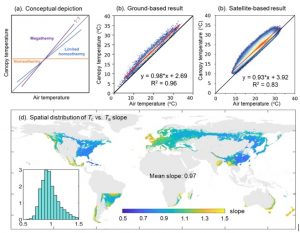
Figure 1. Plant ecosystems exhibit diverse thermoregulation patterns across the extratropics. (a) The conceptual depiction of different plant thermoregulation patterns; Tc vs. Ta relationship from ground-based (b) and satellite-based (c) data. (d) Spatial-wide regression slopes between Tc vs. Ta.
Temperature importantly mediates various activities and processes of terrestrial plants, ranging from photosynthetic metabolism on cells to species distributions on ecosystems. The alternation of terrestrial photosynthetic rates and species re-distributions with global climate change would generate impacts on the ecosystem health and carbon sequestration strength, which ultimately affects us human wellbeing in terms of key ecosystem services that we can acquire from the natural ecosystems. Critical to accurate projections of terrestrial ecosystems’ metabolic response and resilience to changing climates is to understand the degree to which plants thermoregulate their canopy temperature (Tc) in response to the change in ambient air temperature (Ta).
Plant thermoregulation refers to the maintenance of relatively stable Tc in the face of variable Ta. It could result from a wide suite of structural, morphological, and physiological traits, and can be quantified in two ways: the regression slope of Tc vs. Ta as well as the difference between Tc and Ta (ΔT). Specifically, it has been hypothesized that if thermoregulation occurs: 1) Tc will change more slowly than Ta over time, leading the Tc vs. Ta regression slope to be less than 1 (the blue line in Fig. 1a); 2) Tc is cooler than Ta when Ta exceeds some threshold, typically during the midday high light conditions. Despite its topical importance, debates remain in literatures, with divergent opinions ranging from no to moderate plant thermoregulation capacities.
To advance the understanding of this topic, an international team of terrestrial scientists from HK, Mainland China, South Korea, and US, including Dr. Jin Wu (Assistant Professor from the School of Biological Sciences, HKU), Mr. Zhengfei Guo (Ph.D. candidate from the School of Biological Sciences, HKU), Dr. Christopher Still (Professor of Forest Ecosystem Science, Oregon State University), Dr. Timothy Bonebrake (Associate Professor from the School of Biological Sciences, HKU) and Dr. Alice Hughes (Associate Professor from the School of Biological Sciences, HKU) collaborated to evaluate the occurrence of plant thermoregulation among various ecosystems around the world.
With the aid of both ground site-level eddy covariance and satellite data with continuous global coverage, the team conducted a comprehensive assessment of plant thermoregulation capacity across global extratropics, with three main findings. First, regardless of the metrics used to indicate plant thermoregulation capacity, more than 80% of the studied ecosystems have slopes≥1 and midday Tc>Ta, rejecting the ‘limited homeothermy’ hypothesis. Second, for those sites unsupporting the ‘limited homeothermy’ hypothesis, their Tc–Ta difference (ΔT) still exhibits considerable seasonality that shows negative, partial correlations with plant canopy structure seasonality, implying a certain degree of thermoregulation capability. Third, spatial-wide ΔT exhibits large variation (0-6°C), which is dominantly explained by environmental variables (38%) and secondarily by biotic factors (15%).
“Our study addresses an important issue, i.e., do plants regulate their own temperatures? This foundational knowledge has the potential to affect many aspects of how we understand plants, we have addressed this with FLUXNET and satellite analysis, bringing “big data” to the ‘classic ecology question’ in a way that never has been done so in the past.” said Dr. Jin Wu. “Our results demonstrated that diverse thermoregulation strategies exist across global ecosystems from limited thermoregulation to poikilothermy and megathermy (Fig. 1a), implying previous findings may not be incompatible, instead, they are likely caused by different abiotic and biotic factors” complemented by Mr. Zhengfei Guo. “This work also raises real-world awareness: the temperatures of plants will experience as a consequence of climate change. Here, we show that canopy leaves are typically warmer than air, implying future warming is unlikely to be mitigated by canopy cooling” said Dr. Christopher Still.
The journal paper can be accessed in New phytologist.

